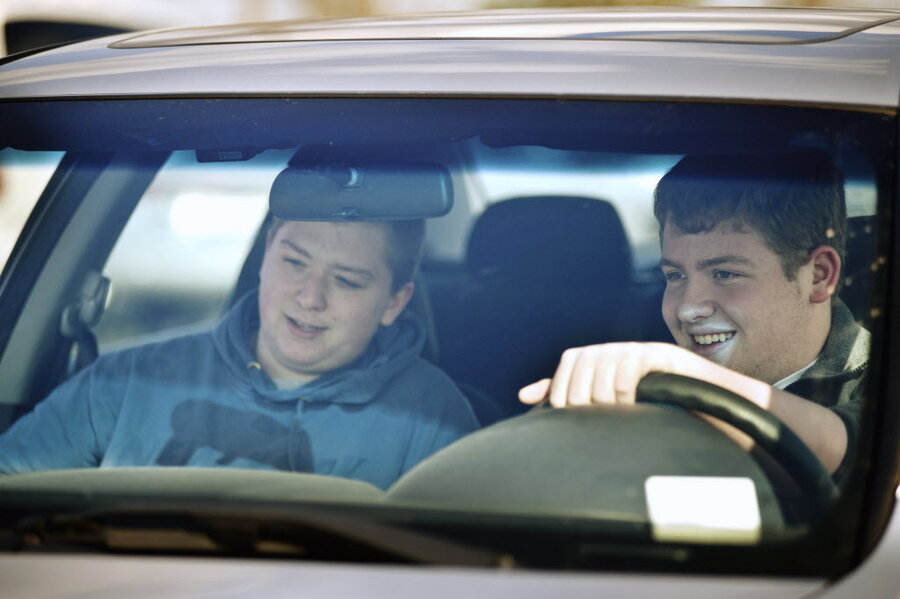Why teen driving deaths have tumbled to historic lows
Loading...
Teenage driving deaths have registered a historic decrease, dropping 64 percent since 1975, the first year that the Insurance Institute of Highway Safety kept such data.
US traffic deaths for all age groups continue to plunge at a record-shattering pace. An estimated 32,310 people died in traffic accidents in 2011, marking a 1.7 percent year-over-year decline and a seven-year downward trend, according to the National Highway Traffic Safety Administration. The number of road deaths is the lowest since record keeping began in 1949, well before the creation of the American highway system.
But the data underscore the importance of the trend for teens, considering that motor vehicle accidents are the leading cause of death for teenagers, with 3,115 killed in 2010 – down from more than 8,000 in 1975.
“Without a doubt, the vast reduction of teen driving fatalities has been one of the biggest successes of highway safety we’ve made,” says Jonathan Adkins, a spokesman for the Governor’s Highway Safety Association. “But traffic fatalities are still the No. 1 killer of teens, so while we’ve made dramatic progress, we need to learn from our successes to keep that going.”
A nationwide crackdown on drunk driving, increased use of seat belts, and improved vehicle design have all played a role, as has the tepid economy, which has trimmed teen's driving habits. But the biggest reason for the shift is the robust system of graduated driver’s licensing laws that all 50 states have enacted to varying degrees. These typically require new drivers to pass through three stages: acquiring a learner’s permit, progressing to a restricted license, and finally obtaining a full driver’s license.
“Graduated licenses are probably the most effective intervention to protect teens that has been broadly implemented,” says Bruce Hamilton, coordinator of research and education at the AAA Foundation for Traffic Safety. “We have gone to great lengths to protect teens and to reduce risky and potentially hazardous situations when they are first learning to drive and at their most inexperienced.”
Graduated licenses, which also set stricter requirements for supervised practice hours and night driving, are nothing new. Florida was the first state to enact such a system in 1996. Still, it seems, the breadth of the various state laws has contributed to the positive trend. In fact, the tiered-licensing system can be credited with a nearly 40 percent reduction in 16- and 17-year-old drivers' involvement in fatal crashes, Mr. Hamilton says.
Additionally, far more teens are waiting past their 16th birthday to get a driver’s license. Data from the Federal Highway Administration indicate that some 30.7 percent of 16-year-olds got their licenses in 2008, compared with 44.7 percent in 1998.
One reason for this decline could be that traditional driver’s education courses for new drivers are becoming less available. Many high schools are increasingly rolling back formal driver training because of funding shortages, according to officials at the Center for the Study of Young Drivers at the University of North Carolina. This means families who want a driving course must scrounge up $300 to $700 for private driving schools. Generally, after age 18, states do not require new drivers to undergo any formal instruction.
What’s more, the economic downturn has been credited – or blamed – for a sharp drop in the number miles driven overall by Americans in recent years. Of particular importance for teens, however, is that families have undoubtedly blocked would-be drivers from getting behind the wheel by cutting back on car insurance and gas expenses.
“We suspect the economy has reduced teen drivers,” says Mr. Adkins of the Governor’s Highway Safety Association. “Teens are optional drivers, and any time you have financial strain, you cut optional expenses across the board, so that may be another reason why fewer teens are dying.”
Still, concern about distracted driving among teens when they finally do get a driver’s license is high. The AAA Foundation for Traffic Safety reported this week that the chance of teenage drivers dying in a crash increases significantly with every additional teenage passenger in the car.
Conversely, a new survey released the same day by Consumer Reports also found that drivers ages 16 to 21 are less likely to want to talk on the phone, text, or engage in other dangerous distracted driving if they bring a friend along for the ride.
Whatever the case, experts say there’s no magic bullet to getting rid of the problem entirely, especially since there’s always a new crop of teen drivers every year.
“It’s absolutely outrageous and unacceptable that more than 3,000 teens are dying on the road every year,” says Hamilton of the AAA Foundation for Traffic Safety. “We need to continue to make more progress by strengthening graduated licensing laws, driver’s education, and getting parents more involved in their teen’s transition behind the wheel and onto the road.”








